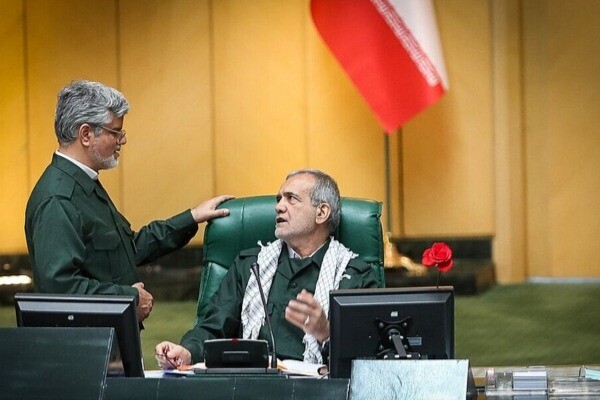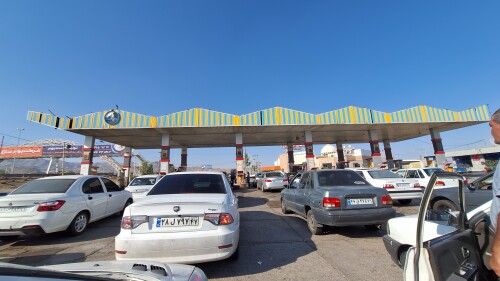On August 11, Iranian president Masoud Pezeshkian submitted his list of cabinet nominees to parliament after receiving Supreme Leader Ali Khamenei’s endorsement. The hardliner-dominated legislature has been reviewing the list and will vote on the new cabinet soon.
Although Pezeshkian did not promise any radical changes during his election campaign, he did signal that he would rely on more experienced individuals to form an effective government equipped to solve long-term problems, including low economic growth and international isolation. Blaming the country’s recent issues on incompetent and unqualified managers, he promised to replace them with experienced technocrats, bring transparency to government spending, and combat corruption—the same issues Khamenei had previously cited as preconditions for national improvement.
The proposed cabinet certainly checks the “experienced” box, with nominees whose median age is sixty—significantly older than his predecessor’s young cabinet. Yet given the compromised process by which these nominees were selected, the creaky institutions they will inherit, and the unqualified staff that will join them, Pezeshkian’s ministers will be hard-pressed to find the solutions he and Khamenei are avowedly seeking.
Hobbled Institutions
Most observers do not expect the new president to change the regime’s main policies or strategic direction, and Pezeshkian himself made clear from the start that he does not want to do so even if he could. Yet many inside Iran and abroad hope that he will at least be able to moderate the regime’s worst behaviors and create a more capable government by appointing a less ideological, more practical bureaucracy.
The Islamic Republic is now a tangled web of hobbled state institutions and numerous additional bodies, with most of the power concentrated in unelected entities.
This hope is likely in vain, however. Enhancing state capacity requires institutional autonomy, meritocracy, and social cohesion, none of which exist in the Islamic Republic more than four decades after its inception. Far from achieving autonomy, most of the state’s bureaucracy is taken up by ideological zealots who are hired and promoted despite their lack of expertise, even as non-ideological technocrats are constantly purged. Under such conditions, the very idea of meritocracy has evaporated.
The Islamic Republic is now a tangled web of hobbled state institutions and numerous additional bodies, with most of the power concentrated in unelected entities. For decades, Iranians have widely understood that this structure is determined by Khamenei, who wields absolute power over the country’s social, cultural, military, and foreign policy decisions. The Islamic Revolutionary Guard Corps (IRGC) buttresses this ideology by dominating most of Iran’s decisionmaking institutions, resulting in entrenched initiatives like a nuclear program that has drained hundreds of billions of dollars from the economy and created decades of tension with the West. Pezeshkian’s government will advise the Leader and the Guards, but he will not change their calculus or loosen their ruinous grip on Iran’s institutions.
Pezeshkian’s Process Exacerbates the Problem
The new president is completely aware of this situation and has seemingly chosen to double down on the status quo rather than push back. Since Khamenei assumed leadership in 1989, he has taken over the most important parts of the cabinet selection process by handpicking crucial ministers or requiring presidents to seek his pre-approval before submitting certain names to parliament. These include the heads of the Foreign Ministry, Interior Ministry, and Intelligence Ministry, the ministers responsible for higher and general education, and the head of the Ministry of Culture and Islamic Guidance.
Pezeshkian’s selection process will likely wind up undermining his own government’s efficacy, since Khamenei and his regime organs have long prioritized ideological commitment over technical expertise.
In the past, disagreements about these posts or the policies they tried to carry out sometimes led to political tension between the president, the Supreme Leader, and unelected bodies. In contrast, Pezeshkian has consulted with Khamenei on all of his cabinet nominations from the beginning. Although he did so with the avowed goal of reducing tension between state institutions, this approach went against the recommendations of his own campaign’s Strategic Council for Transition, which was formed to search for and propose technocratic candidates. Indeed, Pezeshkian’s selection process will likely wind up undermining his own government’s efficacy, since Khamenei and his regime organs have long prioritized ideological commitment (taahhod) over technical expertise (takhasoos) when selecting regime managers.
Some of the president’s most important nominations quickly angered his supporters and the wider reformist camp. For intelligence minister, he chose the disreputable incumbent Esmail Khatib; for interior minister, he nominated Eskandar Momeni, an IRGC commander; and his proposed education minister is Alireza Kazemi, brother to the chief of IRGC intelligence. Such picks drove Mohammad Javad Zarif to resign from his new job as vice president for strategic affairs after only a week and apologize to people who voted for Pezeshkian.
Deeper Layers of the Bureaucracy Also Affected
The second step in forming the cabinet is parliamentary approval. Although Speaker of Parliament Muhammad Baqer Qalibaf has a good relationship with Pezeshkian, most of the chamber’s other representatives are closer to the hardline camp. This includes the “Paydari Front,” a faction that backed his hardline opponent Saeed Jalili in the presidential campaign. Of course, most of Pezeshkian’s nominees will likely be approved given that they received Khamenei’s support. Yet Pezeshkian will still need to maintain working relations with Paydari members, some of whom are still unhappy with Khamenei’s decision to facilitate his election. This political gap only increases the risk of paralysis for Pezeshkian’s government, much like what happened to the past reformist governments of Hassan Rouhani and Mohammad Khatami.
Moreover, cabinet approval is just part of the story—the president also needs to appoint approximately 900 undersecretaries, ambassadors, and provincial governors, either directly or indirectly. Four different institutions will need to approve the credentials of these appointees; according to a document leaked from the Office of the President last year, these bodies are the Supreme Audit Court, the General Inspection Organization, the Ministry of Intelligence, and IRGC intelligence. They will review each appointee’s ideological qualifications, security credentials, and political and ideological commitment to the regime, along with any history of embezzlement or other corruption. The ideological nature of the security apparatus ensures an efficient filtering out of dissidents and a preference for committed loyalists.
The steady “dumbification” of the Iranian state and erosion of its bureaucratic effectiveness have exacerbated long-term structural problems in various aspects of Iranian life, including sociopolitical, economic, and environmental issues.
This screening process has been implemented at all bureaucratic levels for decades, especially middle management. Every ministry and other major government body includes two political screening offices: Gozinesh (selection) and Herasat (protection). These offices were created to ensure the selection of regime zealots and block “penetration” by candidates who lack the requisite amount of religious and ideological commitment (whether real or feigned). By basing its screening criteria on aspects unrelated to the jobs being filled, and by frequently replacing experts with unqualified loyalists, the regime has greatly eroded the modern bureaucracy established during the Pahlavi era. The widespread marginalization and expulsion of capable technocrats has made it difficult for any government to implement even benign state policies effectively.
This practice began in the early days of the Islamic Republic, when the regime quickly and comprehensively replaced pre-revolutionary experts with inexperienced Khomeinist revolutionaries. After the Iran-Iraq War and the demise of Ayatollah Ruhollah Khomeini, presidents such as Akbar Hashemi Rafsanjani and Mohammad Khatami tried to resolve this post-revolutionary paradox by hiring experts in state institutions wherever they could. Yet Khamenei saw this trend as a sign of weakening revolutionary attitudes and eventually facilitated the election of Mahmoud Ahmadinejad’s hardline government as an antidote to those who would “normalize” the Islamic Republic.
Years later, President Rouhani tried to once again slow the ideological infiltration of state bureaucracy, but Khamenei fought back by publishing a manifesto called “The Second Step of the Islamic Revolution,” which called for rejuvenating the regime and creating a young and ideologically hardline government. With the Supreme Leader’s support, Ebrahim Raisi’s government replaced many older technocrats with a new generation of ideological technocrats, including the so-called “Imam Sadeqis” (so-named because they hail from Imam Sadeq University, one of the regime’s main institutions for training its brand of “revolutionary” civil servant).
Implications
The steady “dumbification” of the Iranian state and erosion of its bureaucratic effectiveness have exacerbated long-term structural problems in various aspects of Iranian life, including sociopolitical, economic, and environmental issues. Although this bureaucracy is still formally under the president’s control, a host of worsening problems—from the politicization of the appointment process to the influx of unqualified zealots, the steady marginalization of experts, and the proliferation of unelected bodies—make it unlikely that Pezeshkian will be able to implement his promised technocratic policies effectively (assuming he intended to reform the system in the first place). This also means that his government’s chances of solving Iran’s long-term problems are very slim.
Instead, Pezeshkian may be destined to run into the same institutional entanglements and paralysis that rendered his predecessors unable to govern efficiently. The likely results seem clear: more popular resentment at home, an eventual return to mass protests, and little if any ability to effectively engage with the international community on major issues like the nuclear program or regional escalation.







